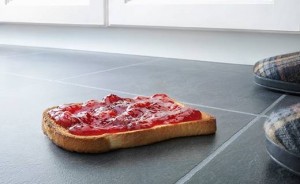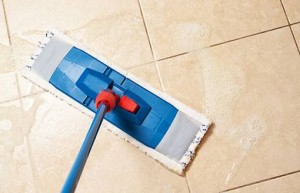The situation: You’re prepping dinner, and a juicy tomato slice slips off the cutting board and onto the kitchen floor you haven’t mopped in a month. You scoop it back up and throw it the salad bowl, because tomatoes aren’t cheap?and hey, aren’t you protected by the 5-Second Rule?
 What you’re worried about: contracting some bowel-razing strain ofSalmonella, E. coli, or another illness-causing bug (that all lead to food recalls.). After all, you’ve been trampling on that floor in the same shoes you’ve worn?well, you don’t even want to think about all the subway stairs, city streets, or dirty fields they’ve crossed.
What you’re worried about: contracting some bowel-razing strain ofSalmonella, E. coli, or another illness-causing bug (that all lead to food recalls.). After all, you’ve been trampling on that floor in the same shoes you’ve worn?well, you don’t even want to think about all the subway stairs, city streets, or dirty fields they’ve crossed.
The very worst that could happen: Germaphobes, you’re allowed to say I told you so. Turns out fallen food does pick up germs immediately upon making contact with the floor, and the amount of bacteria transferred can be enough to make you sick, according to Paul Dawson, PhD, a food science professor at Clemson University. (These 5 foods are so dangerous that they’re illegal in the United States.)
Dawson should know: He actually went so far as to test the 5-Second Rule in a study, which was published in the Journal of Applied Microbiologyin 2007. He and his team dropped slices of bologna and bread onto floors contaminated with Salmonella, let them sit for varying amounts of time, and recorded exactly how many bugs moved from floor to food. When the edibles were dropped on wood or tile and left there for 5 seconds, anywhere from 48% to 70% of bacteria from the floor made it onto the food. (Score one, though, if you’re the rare person who has carpeting in the kitchen: Less than 1% of bacteria were transferred to food dropped on rugs.)
 Before you freak out, know that bacteria on your food becomes a problem if?and only if?the microbes on the floor are actually the kind that can make you sick, like Salmonella. Then, your food would have to fall directly on top of those bugs to really transfer. And harmful bacteria isn’t necessarily on your kitchen floors?you’d have to bring home contaminated food for there to even be a chance. (Like when the FDA found human waste in this food.)
Before you freak out, know that bacteria on your food becomes a problem if?and only if?the microbes on the floor are actually the kind that can make you sick, like Salmonella. Then, your food would have to fall directly on top of those bugs to really transfer. And harmful bacteria isn’t necessarily on your kitchen floors?you’d have to bring home contaminated food for there to even be a chance. (Like when the FDA found human waste in this food.)
But if you do have contaminated goodies at home, it’s actually pretty easy for bacteria to end up on your floor?in other words, you don’t have to mop your floor with a raw chicken breast to create risk. Some strains of E. coli are so powerful, in fact, that it can take as few as 10 cells to cause illness. So even while the possibility of getting sick is still slim, if you have a compromised immune system, don’t take any chances by eating food that’s been on the floor, Dawson says.
 What will probably happen: Nothing. “The odds are extremely low of getting sick from eating fallen food,” Dawson says. And since the majority of the food you bring into your kitchen isn’t contaminated with illness-causing bugs, you’ll likely be just fine if you eat a slice of toast from your kitchen tile. But to minimize your risk, consider staying on top of food recalls from the FDA by singing up for its regular email alerts here.) Then, if you hear a product is being recalled for bacterial contamination, you can toss it before it has the chance to infect your floors. Of course, regularly cleaning your kitchen helps, too, so about once a week, give counters and floors a good scrub, then follow with a disinfectant, says Dawson.
What will probably happen: Nothing. “The odds are extremely low of getting sick from eating fallen food,” Dawson says. And since the majority of the food you bring into your kitchen isn’t contaminated with illness-causing bugs, you’ll likely be just fine if you eat a slice of toast from your kitchen tile. But to minimize your risk, consider staying on top of food recalls from the FDA by singing up for its regular email alerts here.) Then, if you hear a product is being recalled for bacterial contamination, you can toss it before it has the chance to infect your floors. Of course, regularly cleaning your kitchen helps, too, so about once a week, give counters and floors a good scrub, then follow with a disinfectant, says Dawson.
Credit : http://www.eatclean.com/scoops/what-happens-if-you-eat-food-that-fell-on-the-floor
